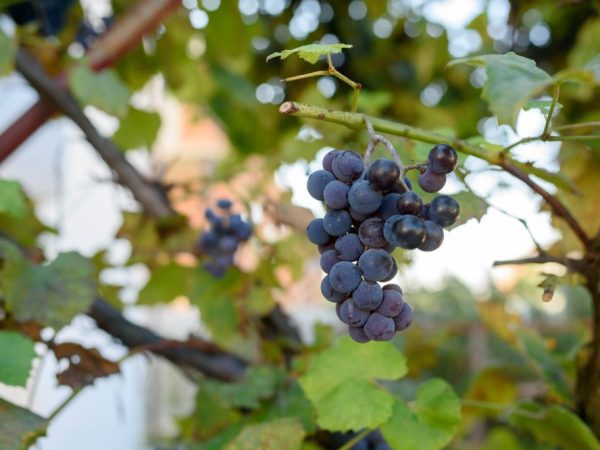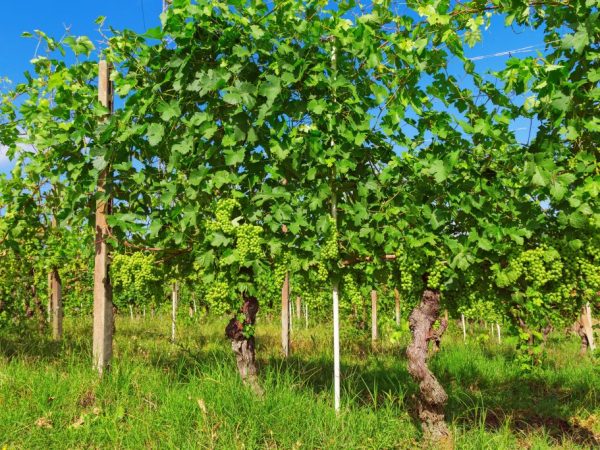Growing grapes Neretinsky
A large number of grape varieties are grown on the territory of Russia. Neretinsky grapes are not included in this list. Despite the large number of positive qualities, it does not inspire confidence among gardeners.

Growing grapes Neretinsky
Variety characteristics
The grapes of the Neretinsky variety are characterized by a tall bush. The average plant height is 5 m. The vine is dense and powerful. Shoots of a delicate green shade change their color to brown in autumn. For 2 years after planting, the vine is covered with brown bark and peels off a little.
Description of Neretinskiy grapes:
- leaves are large, oval;
- the outer part of the leaf is smooth, and the inner part is slightly rough;
- flowering occurs with female flowers, therefore bisexual varieties are planted next to this variety;
- fruiting occurs 3 years after planting;
- harvesting occurs at the beginning of September;
- resistance to frost up to -35 ° C is observed.
Features of the fruit
Rounded grapes of the Neretinsky variety are small. The weight of each does not exceed the mark of 2 g. The peel is dense, but this does not affect the taste. The color of the berries is bright blue. There is a waxy coating on the surface of the fruit.
According to the description, the clusters are small. Their weight does not exceed 200 g. The shape is conical, slightly elongated at the ends. With insufficient care, some clusters can crack, the berries begin to fall off.
The pulp is juicy. The taste is sweet, with a slight sourness. There is a positive effect on human health, since ascorbic acid is present in the composition.
Growing rules
When growing this variety, they carefully choose the soil. Good yield indicators are noted on soils with an average fertility rate. A well-lit area is considered the best place to plant.
It is better to plant plants near fences: they protect the bushes from sudden gusts of wind. The variety well tolerates groundwater close to the surface of the earth.
It is better to buy annual seedlings. They should have a place indicating the vaccination. The optimum height of a young seedling is 1 m. The roots should be developed, up to 30 cm in length.
Planting is carried out in early spring, but for this, they begin to prepare a planting site in the fall. The site is dug up, the roots of the weeds are removed. After that, dig a hole 80 cm deep and 70 cm wide. The bottom is lined with rubble, which will act as a drainage system. After that, the hole is sprinkled with organic fertilizers by 2/3. In this state, the pit should stay until spring. On the day of planting, a small mound is made in the hole, into which the seedling is placed.
The root system of a young plant is covered with the soil remaining after digging. Planting material is watered with 20 liters of warm water. A metal support is dug in next to it, since the plant is vigorous.
Care advice

Plants are easy to care for
Caring for Neretinsky grapes is simple, but takes time.
- The first watering is carried out 2 years after planting.At this time, 15 liters of water are poured under each bush. The further interval of irrigation works is 1 month. To do this, a trench is dug around the bush 10 cm deep. Water is poured in, distributing it over the entire root area. A few days before watering, the soil is loosened and all weeds are eradicated. This helps moisture and fertilizer to penetrate better.
- Top dressing is carried out using both organic matter and mineral fertilizers. In the spring, a few weeks before bud break, they are watered with potassium nitrate (10 g per 5 l of water). During the period of fruit ovary, organic fertilizers are applied in the form of compost and peat, mixed in a 1: 1 ratio. Each bush should have 1 bucket of such a mixture. In early September, the plants are fed with a superphosphate solution (30 g per 7 L of water). Each bush should have 15 liters of liquid solutions. They are often combined with watering.
- Pruning is carried out, depending on the condition of the bush. As soon as dry areas begin to appear, they are immediately removed. Shoots are cut so that no more than 5 eyes remain on them.
Disease and pest control
The grapes of the Neretinsky variety are characterized by low resistance to downy mildew. When it appears, spraying with Bordeaux liquid is immediately carried out (30 g per 6 liters of water).
In the fight against fruit rot, a solution of colloidal salt (20 g per 4 l of water) helps. The preparation "Khomus" (20 g per 10 liters of water) helps to get rid of olive spot.
Birds, aphids, and flea beetles often infest Neretino grapes. It is pointless to fight birds with chemical spraying; it is better to use cover nets. An uncovered bush will be completely destroyed by pests in 3 days.
An effective remedy against aphids and fleas will be "Oxyhom". The drug is characterized by a high concentration of copper in the composition. In 10 liters of water, dilute 50 g of the drug. Spraying is carried out at the intervals specified in the instructions.
Conclusion
Despite the large number of positive qualities, this variety is not popular among gardeners. This is primarily due to its low resistance to mildew. This disease is especially common in countries with a temperate climate.


